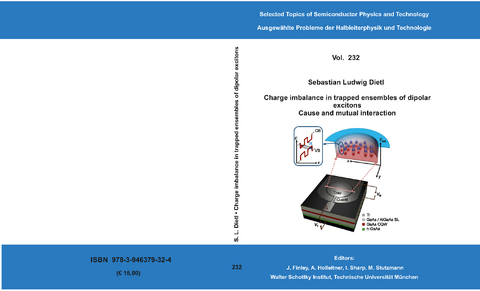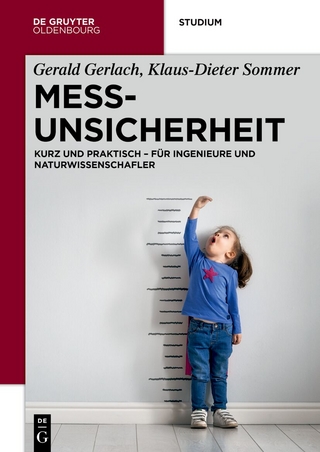
Charge imbalance in trapped ensembles of dipolar excitons Cause and mutual interaction
Seiten
2020
Verein zur Förderung des Walter Schottky Instituts der Technischen Universität München (Verlag)
978-3-946379-32-4 (ISBN)
Verein zur Förderung des Walter Schottky Instituts der Technischen Universität München (Verlag)
978-3-946379-32-4 (ISBN)
- Keine Verlagsinformationen verfügbar
- Artikel merken
During the last decades, excitons have attracted great scientific interest due to their general relevance as fundamental excitation in solids, and due to their outstanding tunability in terms of radiative lifetime, density, and interaction strength. In this work, we focus on the so-called dipolar or indirect exciton (IX), which is characterized by a spatial separation between electron and hole. Lots of effort has been made to investigate the low-temperature physics of IXs, because their bosonic character and complex interaction are expected to lead to a broad variety of different phases and particle correlations. Mainly, this is enabled by their long radiative lifetime in the order of hundreds of nanoseconds. In particular, we focus on the coexistence of neutral IXs and charged IXs, so-called trions. Trions can form if there are free charge carriers present in the exciton ensemble, i.e. there is a charge imbalance. Finite densities of excess charge carriers, comparable to the density of neutral excitons, have been reported in earlier studies.
We optically excite dipolar excitons in a semiconductor heterostructure with a pair of coupled GaAs quantum wells. The lateral confinement of excited excitons relies on established electrostatic trap geometries defined by metallic electrodes on the sample surface. Such field-effect devices exploit the quantum confined Stark effect to create an effective trapping potential for IXs. In the first part of this work, we study the IX-trion ensembles by means of inelastic light scattering. Particularly resonant Raman scattering (RRS) is a powerful tool to gain insight into elementary excitations of charge carriers in semiconductors. In combination with photoluminescence (PL) and photocurrent (PC) spectroscopy, we detect a sharp collective excitation at an energy of 0.44 meV. We interpret this mode as collective plasma oscillation of the excess free charge carrier gas coherently coupled to the IX ensemble indicating also collective behavior of the IXs.
In the second part of this work, we focus on the origin of the charge imbalance. Numerical simulations and spatially resolved PL measurements indicate the dissociation of IXs in strong electric fields at the edge of the gate electrodes. We apply a simple model to quantify the density of free charge carriers and extract a trion binding energy of less than 0.4 meV. In temporally resolved PL spectra, we find a strong non-trivial influence of trions on the radiative lifetime of IXs. The main contribution to the measured PC is the drift of free charge carriers to the indium channels which connect the back gate to the corresponding electrode on the sample surface. Once this connection is interrupted, we find significantly less PC and trion emission.
Finally, we investigate the temporal coherence of IX emission with a Michelson interferometer. The extracted temporal coherence length of emitted photons from a purely neutral IX ensemble falls within the limit set by the spectral linewidth. However, we find a pronounced local decrease in interference visibility when the PL signal contains both emission from neutral IXs and trions. We interpret this effect as interference between both spectral contributions, enabled by some sort of coherent coupling. Our model is supported by numerical calculations and PL spectra recorded at elevated temperatures. The presumable coherent coupling between trions and IXs, several micrometers away from the excitation spot, sheds new light on the ongoing research on coherent quantum mechanical exciton states. In particular, a coupling between the bosonic IX system and the fermionic ensemble of free charge carriers is found in both the studies on light scattering on IXs and charge imbalance in IX traps.
We optically excite dipolar excitons in a semiconductor heterostructure with a pair of coupled GaAs quantum wells. The lateral confinement of excited excitons relies on established electrostatic trap geometries defined by metallic electrodes on the sample surface. Such field-effect devices exploit the quantum confined Stark effect to create an effective trapping potential for IXs. In the first part of this work, we study the IX-trion ensembles by means of inelastic light scattering. Particularly resonant Raman scattering (RRS) is a powerful tool to gain insight into elementary excitations of charge carriers in semiconductors. In combination with photoluminescence (PL) and photocurrent (PC) spectroscopy, we detect a sharp collective excitation at an energy of 0.44 meV. We interpret this mode as collective plasma oscillation of the excess free charge carrier gas coherently coupled to the IX ensemble indicating also collective behavior of the IXs.
In the second part of this work, we focus on the origin of the charge imbalance. Numerical simulations and spatially resolved PL measurements indicate the dissociation of IXs in strong electric fields at the edge of the gate electrodes. We apply a simple model to quantify the density of free charge carriers and extract a trion binding energy of less than 0.4 meV. In temporally resolved PL spectra, we find a strong non-trivial influence of trions on the radiative lifetime of IXs. The main contribution to the measured PC is the drift of free charge carriers to the indium channels which connect the back gate to the corresponding electrode on the sample surface. Once this connection is interrupted, we find significantly less PC and trion emission.
Finally, we investigate the temporal coherence of IX emission with a Michelson interferometer. The extracted temporal coherence length of emitted photons from a purely neutral IX ensemble falls within the limit set by the spectral linewidth. However, we find a pronounced local decrease in interference visibility when the PL signal contains both emission from neutral IXs and trions. We interpret this effect as interference between both spectral contributions, enabled by some sort of coherent coupling. Our model is supported by numerical calculations and PL spectra recorded at elevated temperatures. The presumable coherent coupling between trions and IXs, several micrometers away from the excitation spot, sheds new light on the ongoing research on coherent quantum mechanical exciton states. In particular, a coupling between the bosonic IX system and the fermionic ensemble of free charge carriers is found in both the studies on light scattering on IXs and charge imbalance in IX traps.
| Erscheinungsdatum | 18.03.2020 |
|---|---|
| Sprache | englisch |
| Maße | 150 x 210 mm |
| Themenwelt | Naturwissenschaften ► Physik / Astronomie |
| Schlagworte | Galliumarsenide • indirect exciton • photoluminescence |
| ISBN-10 | 3-946379-32-X / 394637932X |
| ISBN-13 | 978-3-946379-32-4 / 9783946379324 |
| Zustand | Neuware |
| Haben Sie eine Frage zum Produkt? |
Mehr entdecken
aus dem Bereich
aus dem Bereich
von den Werkzeugen über Methoden zum TQM
Buch | Softcover (2024)
Springer Fachmedien (Verlag)
32,99 €
kurz und praktisch - für Ingenieure und Naturwissenschafler
Buch | Softcover (2024)
De Gruyter Oldenbourg (Verlag)
44,95 €


